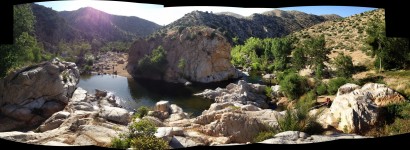…was the destination for a last-minute impulsive day trip – having enviously heard stories from friends of leisurely days spent there over the years; so heading north on the 2, east on the 210 (through the endless Inland Empire), up the 15 (where the San Gabriel Mountains meet the San Bernadino Mountains at the Cajon Pass), off at Main Street in Hesperia (lined with endless anonymous chains and stoplights), on to Bowden Ranch Road (a long windy scenic rough dirt road), terminating at a place to park and hike for another 40 minutes of up and down and dramatic mountain and valley views and rattlesnake dangers, finally depositing you deep to the bottom of the rocky valley in a miragey assemblage of boulders at the bend in a stream with dammed up thermal springs.
From the USDA Forest Service: The landscape surrounding Deep Creek is unique in a southern California context, and its recreation opportunities are valued at the regional and national levels. Thermal hot springs located here are unique and regionally important.Deep Creek supports the greatest diversity of wildlife habitats of any drainage on the San Bernardino National Forest and has earned the State designation of a Wild Trout Stream. It also represents some of the greatest diversity of vegetation communities of any drainage on the national forest. The surrounding area represents a transiticonifer forest. The vegetation ranges from sparse creosote, chamise and California buckwheat at lower elevations to oak and pinyon woodland and scattered mixed conifer, healthy riparian habitats are also present. The Pacific Crest Trail (PCT) follows the creek from the Lake Arrowhead area to the Mojave River Forks Dam for 16 miles as part of the 2,650 mile national scenic trail crossing Deep Creek twice on elevated bridges. For more information on the Pacific Crest Trail, visit their website at www.pcta.org Also Deep Creek is home to the Southwestern Arroyo Toad, an endangered species who lives in the sandy shore of the creek. The toad is a small (2.2-2.9 inches), dark-spotted and light-olive green or gray to tan with dark spots and warty skin. The toad lives from confluence of the Mojave River up to an elevation of 4,300 feet usually spending the day burrowed in the sand and coming out at night to forage for food.

Recent Comments